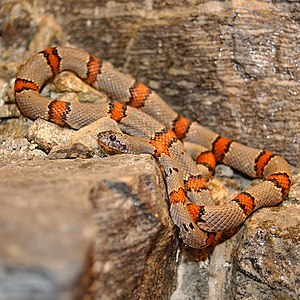King snakes
| King snakes | ||||||||||||
|---|---|---|---|---|---|---|---|---|---|---|---|---|

Lampropeltis alterna |
||||||||||||
| Systematics | ||||||||||||
|
||||||||||||
| Scientific name | ||||||||||||
| Lampropeltis | ||||||||||||
| Fitzinger , 1843 |
The kingsnakes ( Lampropeltis ) are a genus of the family of snakes (Colubridae).
distribution and habitat
The king snakes are mainly found in the USA and Mexico . Some (sub) species also live in Central America and Canada . It prefers dry to moderately humid areas, mostly near grain fields, as it is easy to find food there.
Appearance and behavior
King snakes usually reach a body size of 50 cm to 2 m. They have a relatively thin body with a striking color. In some subspecies, this is similar to the coloration of the poisonous coral otters ( Micrurus sp. ), Which probably serves to protect against enemies ( Batessche mimicry ). They differ from these, however, in the color sequence, which can be remembered with a simple rule of thumb: "If white follows red, you're dead!" (Translated: "If white follows red, you are dead!"). In king snakes, white and red are separated by a black stripe. Another type of defense is making the same sound as that of rattlesnakes ( Crotalus sp. , Cerastes sp. ). They shake their tail and hit it against an object to make a sound. King snakes are immune to the venom of the venomous snakes found in their area . For example, king snakes have been observed eating poisonous snakes, which several bites of the victim could not harm. Depending on the area of distribution, the king snakes keep hibernating for several weeks to several months.
In addition to rodents, birds and frogs, lizards, snakes and eggs also belong to the prey spectrum of lampropelts. The young animals' preferred food is small lizards. Cannibalism can occur in the terrarium, especially among young animals, which is rare in nature.
Systematics
- Gray-banded king snake ( Lampropeltis alterna ) (subspecies: L. a. Alterna and blairi )
- California chain snake ( Lampropeltis californiae )
- Prairie king snake ( Lampropeltis calligaster )
- Lampropeltis elapsoides
- Short-tailed snake ( Lampropeltis extenuata )
- Chain snake ( Lampropeltis getula ) (subspecies: floridana ; getula and nigrita )
- Lampropeltis holbrooki
- Lampropeltis knoblochi
- Mexican king snake ( Lampropeltis mexicana ) (subspecies: L. m. Mexicana ; thayeri and greeri )
- Black chain snake ( Lampropeltis nigra )
- Lamprophelis occipitolineata
- Mountain King Snake ( Lampropeltis pyromelana ) (subspecies: L. p. Infralabialis ; knoblochi ; pyromelana and woodini )
- Lamprophelis rhombomaculata
- Ruthven's king snake ( Lampropeltis ruthveni )
- Lampropeltis splendida
- Triangular snake , also called milk snake ( Lampropeltis triangulum ) (subspecies: L. t. Abnormalma ; amaura ; andesiana ; annulata ; arctifera ; blanchardi ; campbelli ; celaenops ; conanti ; dixoni ; gaigae ; gentilis ; hondurensis ; micropholis ; multistriata ; nelsoni ; oligozona ; oligozona ; oligozona ; polyzona ; sinaloae ; smithi ; stuarti ; syspila ; taylori and triangulum )
- Lampropeltis webbi
- Coral king snake ( Lampropeltis zonata ) (subspecies: L. z. Agalma ; herrerae ; multicineta ; multifasciata ; parvirubra ; pulchra and zonata )
Hazardous situation
The International Union for Conservation of Nature IUCN has ten species of this genus on the Red List of Threatened Species . The coral king snake ( Lampropeltis zonata herrerae ), which is listed as a subspecies in the Systematics chapter, is listed as a separate species ( Lampropeltis herrerae ) and assessed as critically endangered . Another species - Ruthven's king snake ( Lampropeltis ruthveni ) - is considered to be Near Threatened , another six species are classified as Least Concern and two species remain unassessed due to insufficient data ( Data Deficient ).
Web links
Individual evidence
- ↑ a b A.D. McKelvy & FT Burbrink. 2017. Ecological divergence in the yellow-bellied kingsnake ( Lampropeltis calligaster ) at two North American biodiversity hotspots. Molecular Phylogenetics and Evolution 106: 61-72; doi: 10.1016 / j.ympev.2016.09.006
- ^ Lampropeltis in the IUCN Red List of Threatened Species 2009. Accessed March 8, 2010.